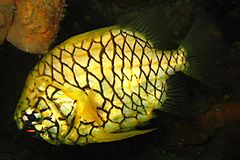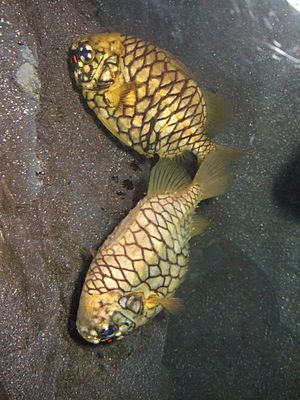Pineapplefish facts for kids
Quick facts for kids Pineapplefish |
|
|---|---|
 |
|
| Pineapple-fish off Fly Point, New South Wales | |
| Scientific classification | |
| Kingdom: | |
| Phylum: | |
| Class: | |
| Order: |
Beryciformes
|
| Family: | |
| Genus: |
Cleidopus
De Vis, 1882 |
| Species: |
C. gloriamaris
|
| Binomial name | |
| Cleidopus gloriamaris De Vis, 1882
|
|
The pineapplefish (Cleidopus gloriamaris) is a special type of fish. It gets its name because its body is covered in large, tough scales. These scales look a lot like the skin of a pineapple! People also call it the knightfish or the coat-of-mail fish because its scales act like armor.
Another cool name for it is the "port-and-starboard light fish." This is because it has two bright spots that glow, just like the lights on a ship. The name "gloriamaris" comes from Latin, meaning "glory of the sea." This fish is the only member of its group, called Cleidopus.
Contents
Where Pineapplefish Live
The pineapplefish lives in the ocean waters near the coast of Australia. You can find it off the shores of Queensland, New South Wales, and Western Australia.
These fish usually live in reefs and harbors. They like to be in water that is about 6 to 200 meters (20 to 650 feet) deep.
What Pineapplefish Look Like
The pineapplefish can grow up to 22 centimeters (about 8.7 inches) long. Its body is round and plump. Almost its entire body is covered in large, rough scales. Each scale has a sharp spine pointing backward.
The scales are usually yellow or whitish. They have black edges, which create the cool pattern that makes the fish look like a pineapple. The fish's head is big and covered in heavy bones, like a helmet. It has a blunt snout that hangs over its wide mouth.
How Pineapplefish Live
Pineapplefish are not very good swimmers. This is because their fins are small and their bodies are stiff from all the armor-like scales.
Nocturnal Habits
These fish are nocturnal. This means they are active at night. During the day, they hide inside caves or under rocky ledges. In one area in New South Wales, a small group of pineapplefish stayed under the same ledge for at least seven years! Another group stayed under a different ledge for three years.
Hunting and Light Organs
At night, the pineapplefish leaves its hiding spot. It swims out over sandy areas to find food. It uses its special light organs to help it see small shrimp to eat.
The light from the pineapplefish comes from tiny living things called bacteria. These bacteria live inside special organs on the fish called photophores. The bacteria and the fish help each other in a relationship called symbiosis. The bacteria that make the light are also found floating freely in the ocean. However, their light fades away a few hours after they leave the fish.
Pineapplefish can live for a long time. Some have lived up to 10 years when kept in aquariums.
Pineapplefish and Humans
Pineapplefish are quite common in deep waters. However, they are shy and like to hide. For a long time after they were first found, people only knew about them from fish that storms had washed ashore.
Sometimes, commercial trawler boats catch pineapplefish by accident. These fish are also popular with people who have saltwater fish aquariums. They are pretty tough fish, but they need rocky places to hide. They also need to be fed live food.
Images for kids
See also
 In Spanish: Pez piña para niños
In Spanish: Pez piña para niños



